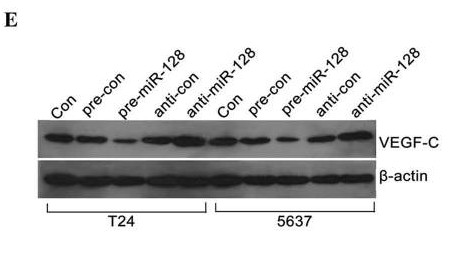VEGF-C Polyclonal Antibody
- Catalog No.:YT5297
- Applications:WB;IHC;IF;ELISA
- Reactivity:Human;Mouse;Rat
- Target:
- VEGF-C
- Fields:
- >>MAPK signaling pathway;>>Ras signaling pathway;>>Rap1 signaling pathway;>>Calcium signaling pathway;>>PI3K-Akt signaling pathway;>>Focal adhesion;>>TNF signaling pathway;>>Relaxin signaling pathway;>>AGE-RAGE signaling pathway in diabetic complications;>>Pathways in cancer
- Gene Name:
- VEGFC
- Protein Name:
- Vascular endothelial growth factor C
- Human Gene Id:
- 7424
- Human Swiss Prot No:
- P49767
- Mouse Gene Id:
- 22341
- Mouse Swiss Prot No:
- P97953
- Rat Gene Id:
- 114111
- Rat Swiss Prot No:
- O35757
- Immunogen:
- The antiserum was produced against synthesized peptide derived from the Internal region of human VEGFC. AA range:91-140
- Specificity:
- VEGF-C Polyclonal Antibody detects endogenous levels of VEGF-C protein.
- Formulation:
- Liquid in PBS containing 50% glycerol, 0.5% BSA and 0.02% sodium azide.
- Source:
- Polyclonal, Rabbit,IgG
- Dilution:
- WB 1:500 - 1:2000. IHC: 1:100-1:300. ELISA: 1:20000.. IF 1:50-200
- Purification:
- The antibody was affinity-purified from rabbit antiserum by affinity-chromatography using epitope-specific immunogen.
- Concentration:
- 1 mg/ml
- Storage Stability:
- -15°C to -25°C/1 year(Do not lower than -25°C)
- Other Name:
- VEGFC;Vascular endothelial growth factor C;VEGF-C;Flt4 ligand;Flt4-L;Vascular endothelial growth factor-related protein;VRP
- Observed Band(KD):
- 42kD
- Background:
- The protein encoded by this gene is a member of the platelet-derived growth factor/vascular endothelial growth factor (PDGF/VEGF) family. The encoded protein promotes angiogenesis and endothelial cell growth, and can also affect the permeability of blood vessels. The proprotein is further cleaved into a fully processed form that can bind and activate VEGFR-2 and VEGFR-3 receptors. [provided by RefSeq, Apr 2014],
- Function:
- function:Growth factor active in angiogenesis, and endothelial cell growth, stimulating their proliferation and migration and also has effects on the permeability of blood vessels. May function in angiogenesis of the venous and lymphatic vascular systems during embryogenesis, and also in the maintenance of differentiated lymphatic endothelium in adults. Binds and activates VEGFR-2 (Flk1) and VEGFR-3 (Flt4) receptors.,PTM:Undergoes a complex proteolytic maturation which generates a variety of processed secreted forms with increased activity toward VEGFR-3, but only the fully processed form could activate VEGFR-2. VEGF-C first form an antiparallel homodimer linked by disulfide bonds. Before secretion, a cleavage occurs between Arg-227 and Ser-228 producing an heterotetramer. The next extracellular step of the processing removes the N-terminal propeptide. Finally the mature VEGF-C is compos
- Subcellular Location:
- Secreted.
- Expression:
- Spleen, lymph node, thymus, appendix, bone marrow, heart, placenta, ovary, skeletal muscle, prostate, testis, colon and small intestine and fetal liver, lung and kidney, but not in peripheral blood lymphocyte.
Eplerenone inhibits UUO-induced lymphangiogenesis and cardiac fibrosis by attenuating inflammatory injury. INTERNATIONAL IMMUNOPHARMACOLOGYInt Immunopharmacol. 2022 Jul;108:108759. Rat 1:100,1:100 heart tissues
LncRNA PVT1 regulates VEGFC through inhibiting miR‐128 in bladder cancer cells. JOURNAL OF CELLULAR PHYSIOLOGY 2018 Aug 04 WB Human 1:500 UM-UC-3 cell
Facilitating colorectal cancer cell metastasis by targeted binding of long non-coding RNA ENSG00000231881 with miR-133b via VEGFC signaling pathway. BIOCHEMICAL AND BIOPHYSICAL RESEARCH COMMUNICATIONS 2018 Dec 20 WB Human 1:1000 HCT-116 cell, Lovo cell
miR-128 downregulation promotes growth and metastasis of bladder cancer cells and involves VEGF-C upregulation. Oncology Letters 2015 Sep 09 WB Human SV-HUC-1 cell,T24 cell, 5637 cell
Facilitating colorectal cancer cell metastasis by targeted binding of long non-coding RNA ENSG00000231881 with miR-133b via VEGFC signaling pathway. BIOCHEMICAL AND BIOPHYSICAL RESEARCH COMMUNICATIONS 2018 Dec 20 WB Human 1:1000 HCT-116 cell, Lovo cell
Eltrombopag Inhibits Metastasis in Breast Carcinoma by Targeting HuR Protein INTERNATIONAL JOURNAL OF MOLECULAR SCIENCES Yuying Zhu WB,IHC Mouse lung tissues,popliteal lymph node 4T1 cell,RAW264.7 cell
- June 19-2018
- WESTERN IMMUNOBLOTTING PROTOCOL
- June 19-2018
- IMMUNOHISTOCHEMISTRY-PARAFFIN PROTOCOL
- June 19-2018
- IMMUNOFLUORESCENCE PROTOCOL
- September 08-2020
- FLOW-CYTOMEYRT-PROTOCOL
- May 20-2022
- Cell-Based ELISA│解您多样本WB检测之困扰
- July 13-2018
- CELL-BASED-ELISA-PROTOCOL-FOR-ACETYL-PROTEIN
- July 13-2018
- CELL-BASED-ELISA-PROTOCOL-FOR-PHOSPHO-PROTEIN
- July 13-2018
- Antibody-FAQs
- Products Images

- Zhou, X. U., et al. "miR-128 downregulation promotes growth and metastasis of bladder cancer cells and involves VEGF-C upregulation." Oncology letters 10.5 (2015): 3183-3190.

- Western Blot analysis of L929 cells using VEGF-C Polyclonal Antibody. Antibody was diluted at 1:2000. Secondary antibody(catalog#:RS0002) was diluted at 1:20000

- Immunohistochemical analysis of paraffin-embedded Human Liver. 1, Antibody was diluted at 1:200(4° overnight). 2, High-pressure and temperature EDTA, pH8.0 was used for antigen retrieval. 3,Secondary antibody was diluted at 1:200(room temperature, 30min).

- Western blot analysis of lysate from L929 cells, using VEGFC Antibody.



